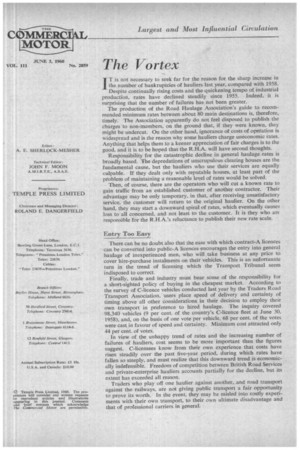The Vortex
Page 39

If you've noticed an error in this article please click here to report it so we can fix it.
IT is not necessary to seek far for the reason for the sharp increase in the number of bankruptcies of hauliers last year, compared with 1958. Despite continually rising costs and the quickening tempo of industrial productibn, rates have declined steadily since 1955. Indeed, it is surprising that the number of failures has not been greater.
The production of the Road Haulage Association's guide to recommended minimum rates between about 80 main destinations is, therefore, timely. The Association apparently do not feel disposed to publish the charges to non-members, on the ground that, if they were known, they might be undercut. On the other hand, ignorance of costs of operation is widespread and is the reason why some hauliers charge uneconomic rates. Anything that helps them to a keener appreciation of fair charges is to the good, and it is to be hoped that the R.H.A. will have second thoughts.
Responsibility for the catastrophic decline in general haulage rates is broadly based. The depredations of unscrupulous clearing houses are the fundamental cause, but the hauliers who use their services are equally culpable. If they dealt only with reputable houses, at least part of the problem of maintaining a reasonable level of rates would be solved.
Then, of course, there are the operators who will cut a known rate to gain traffic from an established customer of another contractor. Their advantage may be only temporary, in that, after receiving unsatisfactory service, the customer will return to the original haulier. On the other hand, they may start a downward spiral of rates, which eventually causes loss to all concerned, and not least to the customer. It is they who are responsible for the R.H.A.'s reluctance to publish their new rate scale.
Entry Too Easy
There can be no doubt also that the ease with which contract-A licences can be converted into public-A licences -encourages the entry into general haulage of inexperienced men, who will take business at any price to cover hire-purchase instalments on their vehicles. This is an unfortunate turn in the trend of licensing which the Transport Tribunal seem indisposed to correct.
Finally, trade and industry must bear some of the responsibility for a short-sighted policy of buying in the cheapest market. According to the survey of C-licence vehicles conducted last year by the Traders Road Transport Association, users place speed of delivery and certainty of timing above all other considerations in their decision to employ their own transport in preference to hired haulage. The inquiry covered 98,340 vehicles (9 per cent, of the country's C-licence fleet at June 30, 1958), and, on the basis of one vote per vehicle, 68 per cent, of the votes were cast in favour of speed and certainty. Minimum cost attracted only 44 per cent. of votes.
In view of the unhappy trend of rates and the increasing number of failures of hauliers, cost seems to be more important than the figures suggest. C-licensees know from their own experience that costs have risen steadily over the past five-year period, during which rates have fallen so steeply, and must realize that this downward trend is economically indefensible. Freedom of competition between British Road Services and private-enterprise hauliers accounts partially for the decline, but its extent has exceeded all reason.
Traders who play off one haulier against another, and road transport against the railways, are not giving public transport a fair opportunity to prove its worth. In the event, they may be misled into costly experiments with their own transport, to their own ultimate disadvantage and that of professional carriers in general.
















































































































